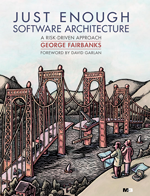SATURN 2019 Workshop - Survivor: Architecture Island
This year’s workshop at SATURN asked its participants to narrow the long list of architecture ideas, much like the TV show Survivor. Our hope was to arrive at a short list we could use to teach newcomers.
What we discovered was that there were core ideas but they varied by the makeup of the team (experienced, distributed, etc.) and by the kind of project (safety-critical, IT, etc.). This was interesting and raises some good questions to dig into.
Here are the fantastic slides (major kudos to Michael Keeling for the content and visuals):
I wrote a position paper (also on the workshop’s Github page) to get us started on the list of ideas.
What are the big ideas in software architecture?
George Fairbanks
3 May 2019
In this workshop, we’ll be discussing which ideas about software architecture we’d keep and which ones we’d be forced to abandon as we confront the dangers on Architecture Island (rather like the TV show Survivor). It seems like a good idea to survey some of the most popular books on software architecture to create an inventory of what ideas we are starting with.
I intended to survey about a dozen books but it took more time than I’d expected so I (so far) have only done two plus my Intro to Software Architecture lecture from 2012. For this workshop, any list is better than no list, but I’d find it interesting to see which ideas span all or most of the books on software architecture.
I picked up Documenting Software Architectures (2nd edition) first as I remembered it as being much like a catalog itself. I skimmed the book and jotted down ideas or topics. There’s a fair amount of bias in this activity: in my haste I may not have noticed an idea, a different reader might notice different ideas, and of course names differ across books and I was trying to align them while jotting down notes. Then I did the same for Software Architecture in Practice (3rd edition) and my intro lecture. I merged those lists into a table, doing some more subjective merging and omitting of topics. If by chance any of the workshop participants notice errors or omissions (I’m looking at you Len Bass) then please let me know and I’ll fix up the table.
Notation: A question mark in the table indicates that I don’t think the topic was covered but I wouldn’t be surprised if I’d overlooked it. The asterisk in the table is meant to be a bullet that nests under the line above, but my efforts to make it render that way have not yet worked.
I included that intro lecture not because it’s in the same league as the two books but because as of 2012 it was my idea of what I’d keep on Architecture Island and I was curious what I’d left out.
| Topic | DSA 2nd Edition | SAP 3rd Edition | Intro to SA |
|---|---|---|---|
| Views (module, C&C / Runtime, Allocation) | Yes | Yes | Yes |
| * Master model unifies views | No | No | Yes |
| Stakeholders | Yes | Yes | No |
| Quality attributes (vs functionality) | Yes | Yes | Yes |
| * Architecture inhibits or enables | Yes | Yes | Yes |
| * Tied to failure risks | ? | ? | Yes |
| Requirements: QA vs feature | Yes | Yes | Yes |
| * QA requirements drive architecture | Yes | Yes | Yes |
| * QA scenarios | No | Yes | Yes |
| * Argument: How this architecture meets requirements | Yes | No | No |
| * Architecturally significant requirements (ASRs) | ? | Yes | Yes |
| Architecture is a subset of design | Yes | ? | Yes |
| Contexts: Technical, lifecycle, business, professional | No | Yes | No |
| Architectural styles / patterns | Yes | Yes | Yes |
| * Module style: decomposition, uses, generalization, layers, aspects, data model | Yes | No | No |
| * Runtime style: pipe and filter, client-server, peer-to-peer, SOA, pub-sub, shared-data, multi-tier | Yes | No | No |
| * Allocation: deployment, install, work assignment | Yes | No | No |
| Tactics | No | Yes | No |
| * Attribute driven design | No | Yes | No |
| Architecture diagrams (vs cartoons) | Yes | ? | No |
| Notaions and ADLs: element catalog | Yes | No | No |
| Product line architectures | Yes | Yes | No |
| Architectural decisions | Yes | ? | No |
| * Rational architecture decisions | No | No | Yes |
| Interfaces: provided and required | Yes | No | No |
| Design reviews | Yes | Yes | No |
| Align architecture and business goals | No | Yes | No |
| Tradeoffs (and ATAM) | No | Yes | Yes |
| Separate: Architecture, architects, architecting | No | Yes | Yes |
| Constraints / guiderails | Yes | Yes | Yes |
| Conceptual model of architecture | Yes | Yes | Yes |
| Architecturally evident coding style | No | No | Yes |
| Architectural hoisting | No | No | No |

